
Introduction to Cattle
Cattle are a domesticated species of large ruminant mammals that belong to the genus Bos.
They are one of the most widely domesticated animals in the world, known for their versatility and importance in various aspects of agriculture, including meat and dairy production, as well as their use as draft animals.
Cattle are herbivores, and their diet consists primarily of grasses, legumes, and other forage. They have a unique digestive system that allows them to efficiently break down and extract nutrients from their feed, making them an essential part of many agricultural ecosystems.
Significance of Cattle in Agriculture:
Cattle play a crucial role in agriculture, contributing to the global food supply, economic development, and the livelihoods of millions of people worldwide. Some of the key ways in which cattle are significant in agriculture include:
Meat Production: Cattle are a major source of high-quality protein, with beef being a staple in the diets of many cultures around the world. The global demand for beef continues to grow, making cattle an important livestock for food security.
Dairy Production: Cows are the primary source of dairy products, such as milk, cheese, and yogurt, which are rich in essential nutrients and an important part of a balanced diet.
Draft Power: In many developing countries, cattle are used as draft animals, providing essential power for plowing, transportation, and other agricultural tasks.
Byproduct Utilization: Cattle byproducts, such as hides, leather, and tallow, are used in a wide range of industries, contributing to the overall economic value of cattle farming.
Ecosystem Services: Cattle can play a role in maintaining healthy grasslands and rangelands, contributing to biodiversity and carbon sequestration when managed sustainably.
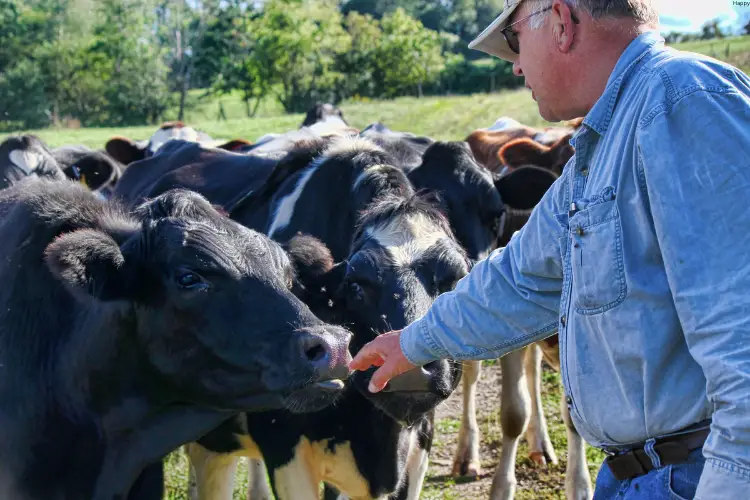
Historical Perspective on Cattle Domestication:
Cattle have a long and fascinating history of domestication, with evidence suggesting that the process began thousands of years ago. The earliest known domesticated cattle are believed to have originated from wild aurochs, a now-extinct species of large bovine that roamed across Europe, Asia, and North Africa.
The domestication of cattle is thought to have first occurred in the Fertile Crescent region of the Middle East, where early human civilizations began to incorporate cattle into their agricultural practices.
Over time, as human populations expanded and settlements grew, the domestication of cattle spread to other parts of the world, including Europe, Asia, and the Americas.
Today, cattle are found in nearly every corner of the globe, with numerous breeds and subspecies adapted to a wide range of environmental and climatic conditions. The continued importance of cattle in agriculture, both as a source of food and as a vital component of many farming systems, has ensured their enduring presence and significance in human societies.

Types of Cattle Breeds
Dairy Cattle Breeds:
Dairy cattle are breeds that are primarily raised for the production of milk. Over centuries of selective breeding, various dairy cattle breeds have been developed, each with its own unique characteristics and attributes.
Here are some of the most well-known and widely-raised dairy cattle breeds:
Holstein-Friesian:
- Characteristics: The Holstein-Friesian is the most popular and widely-distributed dairy breed in the world. Known for their high milk yield, they are large in size with a distinctive black and white or solid black coat color.
- Examples: Holstein-Friesian cows can produce up to 25 liters of milk per day, making them a highly productive breed for commercial dairy operations.
Jersey:
- Characteristics: Jersey cattle are smaller in size compared to other dairy breeds, with a compact and muscular build. They are known for their high-quality milk, which is rich in butterfat and protein.
- Examples: Jersey cows are a popular choice for small-scale and hobby farmers, as they are adaptable to various climates and can thrive on more modest feed inputs.
Ayrshire:
- Characteristics: Ayrshire cattle are medium-sized with a distinctive reddish-brown and white coat pattern. They are known for their hardiness, longevity, and ability to produce high-quality milk.
- Examples: Ayrshire cows are common in northern climates and are often used in crossbreeding programs to improve the productivity and health of other dairy breeds.
Guernsey:
- Characteristics: Guernsey cattle are known for their golden-colored coat and rich, creamy milk. They are slightly smaller than the Holstein-Friesian and are considered efficient converters of feed to milk.
- Examples: Guernsey cows are popular in the United States and Europe, particularly in regions with smaller-scale dairy operations.
Brown Swiss:
- Characteristics: The Brown Swiss breed is known for its adaptability to a wide range of climates and environments. They are large in size and produce high-quality milk with a high butterfat content.
- Examples: Brown Swiss cattle are often used in crossbreeding programs to improve the productivity and hardiness of other dairy breeds, particularly in mountainous or hilly regions.
Milking Shorthorn:
- Characteristics: Milking Shorthorns are a versatile breed, known for their ability to produce both high-quality milk and beef. They are medium-sized with a solid red, white, or roan coat color.
- Examples: Milking Shorthorns are popular in the United States and the United Kingdom, where they are often used in dual-purpose farming operations.
Red and White Holstein:
- Characteristics: The Red and White Holstein is a variation of the traditional Holstein-Friesian breed, with a distinctive reddish-brown and white coat color. They maintain the high milk production and efficiency of the Holstein-Friesian.
- Examples: Red and White Holsteins are increasingly popular in some regions, offering an alternative to the classic black and white Holstein-Friesian.
Normande:
- Characteristics: Normande cattle are a French breed known for their stocky build, short horns, and unique mottled coat pattern. They are considered an excellent dual-purpose breed, producing high-quality milk and beef.
- Examples: Normande cows are well-suited to grazing on rugged, hilly terrain and are often found in traditional dairy farming regions of France and other parts of Europe.
Montbéliarde:
- Characteristics: Montbéliarde cattle are a French breed with a distinctive reddish-brown and white coat. They are known for their high milk production, longevity, and adaptability to various farming systems.
- Examples: Montbéliarde cows are commonly used in the production of traditional French cheeses, such as Comté and Emmental, due to the unique properties of their milk.
Meuse-Rhine-Issel:
- Characteristics: The Meuse-Rhine-Issel (MRI) breed is a dual-purpose cattle breed originating from the Benelux region. They are known for their high milk yield, strong constitution, and good beef qualities.
- Examples: MRI cattle are well-suited to grazing-based production systems and are often found in small-scale dairy farms and organic farming operations in parts of Europe.
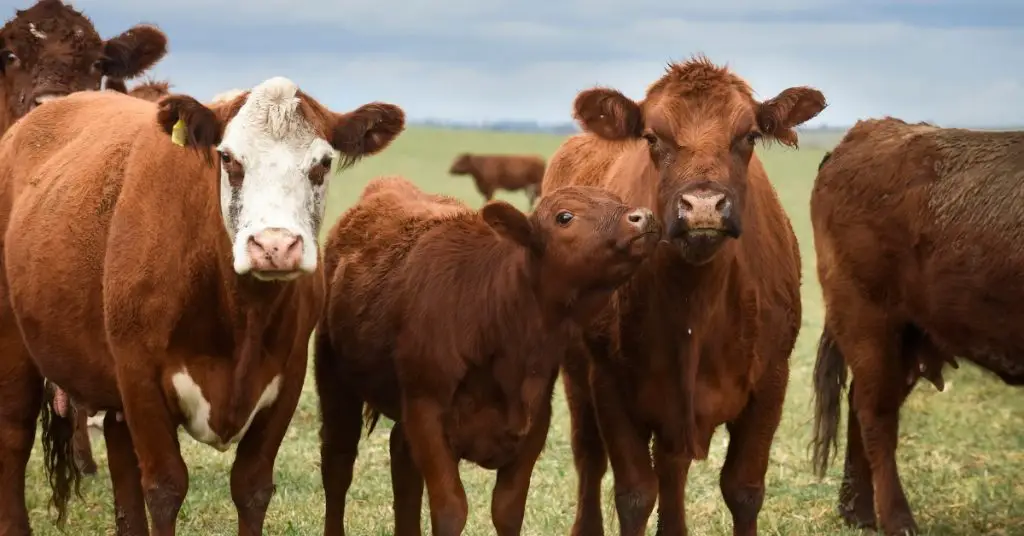
Dairy Beef Breeds:
Dairy beef breeds are a category of cattle that are raised for both milk and beef production.
These breeds are often the result of crossbreeding between dairy and beef cattle, combining the desirable traits of both. Here are some of the most prominent dairy beef breeds:
Milking Shorthorn:
- Characteristics: As mentioned earlier, Milking Shorthorns are a versatile breed known for their ability to produce high-quality milk and beef. They have a compact, muscular build and a solid red, white, or roan coat color.
- Examples: Milking Shorthorns are a popular choice for small-scale and hobby farmers who want to produce both dairy and beef products. Their dual-purpose nature makes them a valuable asset in diversified farming operations.
Dairy Shorthorn:
- Characteristics: Dairy Shorthorns are a breed that has been selectively bred for increased milk production while maintaining good beef qualities. They have a similar appearance to the Milking Shorthorn but are generally larger in size.
- Examples: Dairy Shorthorns are commonly found in the United Kingdom and parts of North America, where they are used in both dairy and beef production systems.
Montbéliarde:
- Characteristics: As mentioned earlier, Montbéliarde cattle are a French breed known for their high milk production and good beef qualities. They have a distinctive reddish-brown and white coat color.
- Examples: Montbéliarde cows are often used in dual-purpose farming operations, providing both high-quality milk and beef to meet the diverse needs of the market.
Brown Swiss:
- Characteristics: The Brown Swiss breed, discussed earlier, is also considered a dairy beef breed due to its ability to produce both high-quality milk and beef. They are large in size and have a solid brown coat color.
- Examples: Brown Swiss cattle are versatile and can be found in both specialized dairy farms and integrated dairy-beef operations, particularly in mountainous regions.
Normande:
- Characteristics: The Normande breed, with its stocky build, short horns, and unique mottled coat pattern, is another example of a dairy beef breed. They are known for their high milk production and good beef qualities.
- Examples: Normande cattle are commonly used in traditional dairy farming regions of France and other parts of Europe, where their dual-purpose nature is highly valued.
These dairy beef breeds offer farmers and producers the opportunity to diversify their operations, leveraging the animals’ ability to provide both high-quality milk and beef.
This can be especially beneficial in smaller-scale or mixed farming systems, where the efficient utilization of resources and the production of multiple revenue streams are critical.
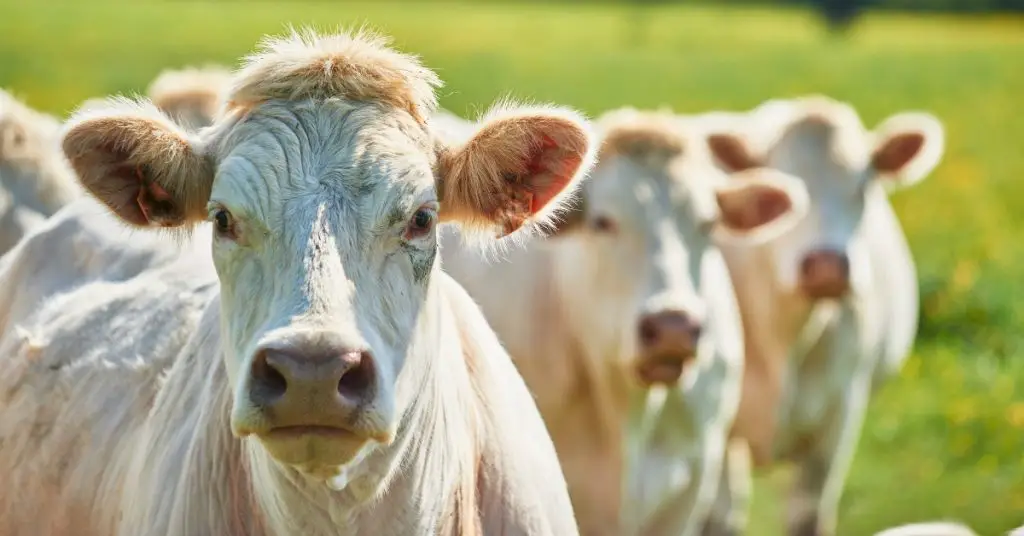
Dual-Purpose Cattle Breeds:
Dual-purpose cattle breeds are those that are raised for both milk and beef production, offering farmers and producers the flexibility to utilize their animals for multiple purposes.
These breeds are often the result of selective breeding that aims to maintain a balance between dairy and beef traits, allowing for efficient utilization of the animals in diversified farming systems.
Characteristics of Dual-Purpose Cattle Breeds:
Dual-purpose cattle breeds typically exhibit the following key characteristics:
Balanced Productivity: Dual-purpose breeds are designed to produce a reasonable amount of both high-quality milk and beef, striking a balance between these two essential agricultural products.
Adaptability: Many dual-purpose breeds are known for their hardiness and ability to thrive in a variety of climatic conditions and farming environments, making them suitable for a wide range of production systems.
Longevity: Dual-purpose cattle tend to have a longer productive lifespan compared to highly specialized dairy or beef breeds, as they are not pushed to their absolute limits in terms of milk or meat production.
Efficient Feed Utilization: These breeds are often efficient converters of feed into both milk and meat, utilizing resources in a more sustainable and cost-effective manner.
Docility: Dual-purpose cattle are generally known for their calm temperament and ease of handling, making them suitable for both small-scale and larger commercial operations.
Examples of Dual-Purpose Cattle Breeds:
Milking Shorthorn:
- As mentioned earlier, the Milking Shorthorn is a prime example of a dual-purpose breed, producing both high-quality milk and beef. They are well-suited for small-scale, diversified farming operations.
Normande:
- The Normande breed, with its distinctive mottled coat and stocky build, is renowned for its ability to produce excellent milk and beef. They are commonly found in traditional dairy farming regions of France and other parts of Europe.
Brown Swiss:
- The Brown Swiss breed, known for its adaptability and hardiness, is also considered a dual-purpose breed, capable of producing substantial amounts of milk and high-quality beef.
Montbéliarde:
- The Montbéliarde breed, originating from France, is another example of a dual-purpose cattle breed that excels in both milk and beef production, making it a versatile choice for farmers.
Meuse-Rhine-Issel (MRI):
- The Meuse-Rhine-Issel breed, found in the Benelux region, is a dual-purpose breed that thrives in grazing-based production systems, providing both milk and beef.
These dual-purpose cattle breeds offer farmers and producers the opportunity to diversify their operations, reduce reliance on specialized breeds, and maximize the utilization of their animal resources.
By maintaining a balance between dairy and beef traits, these breeds can contribute to the sustainability and resilience of agricultural systems, particularly in smaller-scale or mixed farming enterprises.

Cattle Farming Practices
Cattle Management: Best Practices
Effective cattle management is crucial for ensuring the health, productivity, and overall well-being of the animals. Here are some of the key best practices for raising cattle:
Herd Health Management:
- Preventive Healthcare: Implementing a comprehensive preventive healthcare program, including regular veterinary check-ups, vaccination schedules, and parasite control, is essential for maintaining the health of the herd.
- Nutrition and Feeding: Providing a balanced, high-quality diet that meets the nutritional requirements of the cattle at different life stages is crucial for their growth, milk production, and overall performance.
- Housing and Facilities: Ensuring that cattle have access to clean, well-ventilated housing, with adequate space, shelter, and access to clean water, can significantly improve their health and well-being.
Breeding and Genetics:
- Selective Breeding: Implementing a strategic breeding program that selects for desirable traits, such as milk production, fertility, and growth rate, can help improve the genetic potential of the herd over time.
- Reproductive Management: Optimizing breeding schedules, implementing artificial insemination (AI) or natural breeding, and monitoring reproductive performance can enhance the herd’s reproductive efficiency.
- Genetic Testing and Selection: Utilizing genetic testing and selection tools can help identify superior breeding stock and make informed decisions to improve the herd’s genetic makeup.
Pasture and Grazing Management:
- Rotational Grazing: Employing a rotational grazing system, where cattle are moved to different pastures or paddocks, can help maintain the quality and productivity of the grazing land, while also meeting the cattle’s foraging needs.
- Forage Quality and Diversity: Ensuring a diverse and high-quality forage base, through proper pasture management and the incorporation of legumes and other complementary species, can improve the nutritional value of the cattle’s diet.
- Pasture Improvement: Implementing pasture improvement techniques, such as soil testing, fertilization, and reseeding, can enhance the productivity and sustainability of the grazing land.
Animal Welfare and Handling:
- Low-Stress Handling: Adopting low-stress handling techniques, such as quiet movement, gentle prodding, and the use of handling facilities designed with the cattle’s natural behavior in mind, can reduce stress and improve the overall well-being of the animals.
- Animal Comfort and Behavior: Understanding and addressing the behavioral needs of cattle, such as providing adequate shade, shelter, and opportunities for natural behaviors, can contribute to their overall comfort and welfare.
- Responsible Use of Antibiotics: Minimizing the use of antibiotics and promoting the responsible use of veterinary drugs, in alignment with best practices and regulations, can help mitigate the development of antimicrobial resistance.
Record-Keeping and Data Management:
- Herd Monitoring and Performance Tracking: Maintaining detailed records on herd health, breeding, production, and other key metrics can help inform management decisions and optimize the performance of the cattle operation.
- Data-Driven Decision Making: Utilizing data and analytics to monitor and evaluate the performance of the herd, as well as the effectiveness of management practices, can help identify areas for improvement and guide the implementation of best practices.
By adopting these best practices in cattle management, farmers and producers can enhance the health, productivity, and overall sustainability of their cattle operations, while also ensuring the welfare and responsible stewardship of the animals under their care.
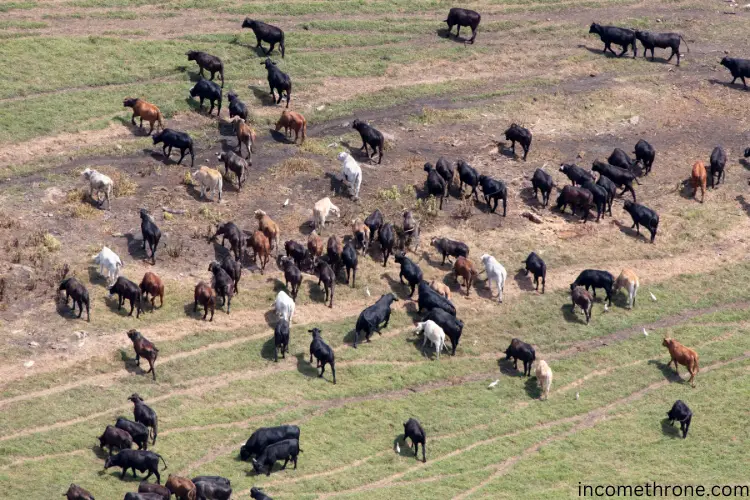
Feeding and Nutrition: Nutritional Requirements for Different Cattle Types
Proper feeding and nutrition are crucial for the overall health, growth, and productivity of cattle. The nutritional requirements vary depending on the specific type of cattle, their life stage, and production goals. Let’s examine the key nutritional needs for different cattle types:
Dairy Cattle:
- Energy: Dairy cows have a high energy requirement, particularly during peak lactation, to support milk production. They need a diet rich in carbohydrates and fats.
- Protein: Dairy cows require a significant amount of high-quality protein to support milk production and maintain body condition.
- Vitamins and Minerals: Dairy cows need a balanced supply of essential vitamins (e.g., vitamins A, D, and E) and minerals (e.g., calcium, phosphorus, and selenium) to maintain optimal health and reproductive performance.
- Water: Adequate access to clean, fresh water is critical for dairy cows, as they have a high water intake requirement, especially during lactation.
Beef Cattle:
- Energy: Beef cattle require a diet that provides sufficient energy, primarily from carbohydrates and fats, to support growth, maintenance, and fattening.
- Protein: Beef cattle need adequate protein, particularly during the growing and finishing stages, to support muscle development and lean tissue growth.
- Forage: Beef cattle thrive on a diet rich in high-quality forage, such as grasses and legumes, which provide essential nutrients and fiber.
- Minerals: Beef cattle require a balanced supply of minerals, including calcium, phosphorus, and trace minerals, to support bone development, immune function, and reproductive health.
Dual-Purpose Cattle:
- Balanced Nutrition: Dual-purpose cattle, raised for both milk and beef production, require a balanced diet that meets the nutritional needs for both milk production and growth.
- Energy and Protein: These cattle need a diet that provides the necessary energy and protein to support their dual-purpose function, with a focus on maintaining a healthy body condition and milk yield.
- Forage and Concentrates: Dual-purpose cattle typically require a combination of high-quality forage and targeted concentrates to optimize their performance and ensure their nutritional requirements are met.
- Vitamins and Minerals: As with dairy and beef cattle, dual-purpose breeds also require a well-balanced supply of essential vitamins and minerals to maintain overall health and productivity.
Growing and Weaning Calves:
- Milk or Milk Replacer: Calves require a diet rich in high-quality milk or milk replacer to support their rapid growth and development during the first few months of life.
- Starter Feeds: As calves transition to solid feed, they require a balanced diet of starter feeds, which are typically high in protein and energy to support their growth and rumen development.
- Forage and Roughage: Gradual introduction of high-quality forage and roughage is essential for the proper development of the calf’s digestive system and rumen function.
Proper feed formulation, balanced rations, and the efficient delivery of nutrients are crucial for meeting the specific nutritional needs of different cattle types.
Consulting with animal nutritionists, veterinarians, and experienced farmers can help ensure that cattle receive the right nutrients to optimize their health, growth, and productivity.
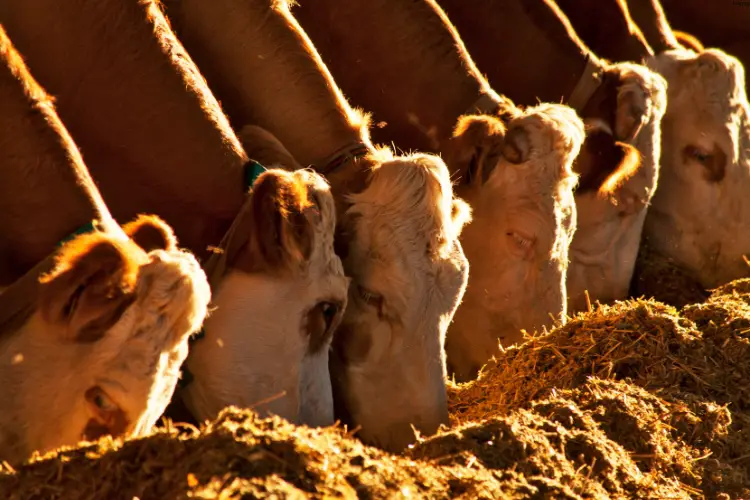
Breeding Techniques: Natural vs. Artificial Breeding
Breeding is a critical aspect of cattle farming, as it directly impacts the genetic makeup, productivity, and overall performance of the herd.
Cattle producers have access to various breeding techniques, each with its own advantages and considerations. Let’s explore the key differences between natural and artificial breeding methods:
Natural Breeding:
Natural breeding, also known as natural service, involves the mating of a bull with a cow or heifer in a natural setting. This traditional method of breeding has been practiced for centuries and is still widely used in many cattle farming operations.
Characteristics of Natural Breeding:
- Bull Selection: Farmers carefully select breeding bulls based on desired traits, such as genetic merit, fertility, and physical characteristics.
- Breeding Seasons: Cattle are typically bred during specific breeding seasons, often timed to coincide with favorable environmental conditions and feed availability.
- Mating Supervision: Farmers may closely monitor and manage the breeding process, ensuring that cows are bred at the appropriate time and that the bulls are performing effectively.
- Herd Sire Management: Bulls used for natural breeding are often rotated or replaced to maintain genetic diversity and avoid inbreeding within the herd.
Advantages of Natural Breeding:
- Simplicity: Natural breeding is a straightforward and low-cost method that does not require specialized equipment or extensive training.
- Suitability for Small-Scale Farms: Natural breeding can be easily implemented in small-scale cattle operations with limited resources.
- Minimal Intervention: Natural breeding allows cattle to express their natural mating behaviors and instincts.
Limitations of Natural Breeding:
- Limited Genetic Diversity: The genetic pool is limited to the available bulls within the herd or those introduced through purchases.
- Reduced Breeding Efficiency: Natural breeding can be less efficient in terms of breeding success rates compared to artificial breeding methods.
- Bull Management: Bulls used for natural breeding require significant management and care to ensure their health, safety, and breeding performance.
Artificial Breeding:
Artificial breeding, or artificial insemination (AI), involves the use of technology to introduce semen from a selected bull into the reproductive tract of a cow or heifer, without the physical presence of the bull.
Characteristics of Artificial Breeding:
- Semen Collection and Processing: Semen is collected from genetically superior bulls, processed, and stored for subsequent use in the breeding program.
- Estrus Synchronization: Farmers may implement estrus synchronization protocols to improve the timing and success of artificial insemination.
- Insemination Procedure: Trained technicians or farmers perform the artificial insemination procedure, ensuring proper placement of the semen.
- Sire Selection: Farmers have access to a broader pool of genetically superior sires, allowing for more targeted genetic improvement.
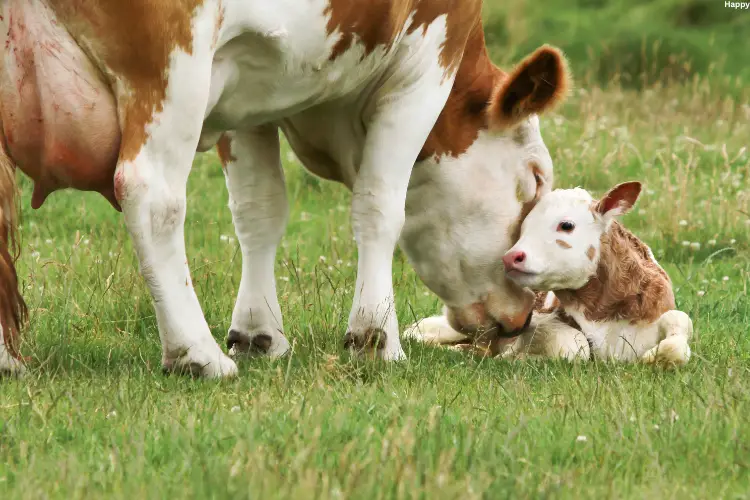
Advantages of Artificial Breeding:
- Genetic Improvement: Artificial breeding enables the use of genetically superior bulls, accelerating the rate of genetic progress within the herd.
- Breeding Efficiency: AI can achieve higher conception rates compared to natural breeding, especially when combined with estrus synchronization.
- Disease Control: Artificial breeding helps mitigate the risk of disease transmission associated with natural mating.
- Reduced Labor and Infrastructure: Artificial breeding requires less infrastructure and labor compared to maintaining a breeding herd of bulls.
Limitations of Artificial Breeding:
- Technical Expertise: Artificial insemination requires specialized training and skills, which may not be readily available in all cattle farming regions.
- Upfront Costs: Implementing an artificial breeding program can incur higher upfront costs for semen, equipment, and training.
- Reproductive Management: Careful monitoring and management of the breeding herd are necessary to ensure the success of artificial breeding.
Both natural and artificial breeding methods have their merits and are widely used in cattle farming operations.
The choice between the two often depends on the scale of the operation, available resources, genetic improvement goals, and the specific needs and preferences of the cattle farmer.

Cattle Health and Welfare
Common Health Issues in Cattle:
Maintaining the health and well-being of cattle is a critical aspect of successful cattle farming. Cattle are susceptible to various diseases and conditions, some of which are more prevalent than others.
Understanding these common health issues is essential for implementing effective disease prevention and management strategies. Let’s explore the overview of the most prevalent diseases and conditions in cattle:
- Infectious Diseases:
a. Bovine Respiratory Disease (BRD): BRD is a complex of viral and bacterial infections that affects the respiratory system of cattle, leading to pneumonia and significant economic losses.
b. Bovine Viral Diarrhea (BVD): BVD is a highly contagious viral disease that can cause a range of symptoms, including diarrhea, respiratory issues, and reproductive problems.
c. Mastitis: Mastitis is an inflammatory condition of the mammary gland, often caused by bacterial infections, which can significantly impact milk production and quality.
d. Foot-and-Mouth Disease (FMD): FMD is a highly contagious viral disease that affects cloven-hoofed animals, including cattle, causing fever and blisters on the feet and mouth. Metabolic and Nutritional Disorders:
a. Ketosis: Ketosis is a metabolic disorder characterized by an abnormal accumulation of ketone bodies, often occurring in high-producing dairy cows during the transition period.
b. Milk Fever (Hypocalcemia): Milk fever is a condition caused by a sudden drop in blood calcium levels, typically occurring around the time of calving, which can lead to muscle weakness and recumbency.
c. Rumen Acidosis: Rumen acidosis is a digestive disorder caused by an imbalance in the rumen’s pH, often resulting from the consumption of too many rapidly fermentable carbohydrates.
d. Bloat: Bloat is a condition caused by the accumulation of gas in the rumen, which can lead to respiratory distress and even death if not treated promptly.Reproductive Issues:
a. Infertility: Infertility in cattle can be caused by a variety of factors, including genetic, nutritional, and environmental factors, as well as specific reproductive disorders.
b. Abortion: Abortion in cattle can be caused by infectious agents, such as bacteria, viruses, and protozoa, as well as non-infectious factors like nutrition, toxins, and physical trauma.
c. Dystocia: Dystocia, or difficult calving, can occur due to factors like fetal abnormalities, pelvic imbalances, or maternal-fetal size mismatch, and may require veterinary intervention.Parasitic Infections:
a. Gastrointestinal Parasites: Cattle can be infected by a range of gastrointestinal parasites, such as nematodes, coccidia, and liver flukes, which can impair the animal’s health and productivity.
b. Ectoparasites: Ectoparasites, like ticks, lice, and mites, can cause skin irritation, anemia, and predispose cattle to secondary infections.
Effective prevention and management of these common health issues in cattle require a comprehensive approach, including proper vaccination programs, appropriate nutrition and feeding strategies, biosecurity measures, and prompt veterinary care when necessary.
Collaborating with veterinarians and implementing evidence-based best practices can help mitigate the impact of these diseases and conditions on cattle health and productivity.
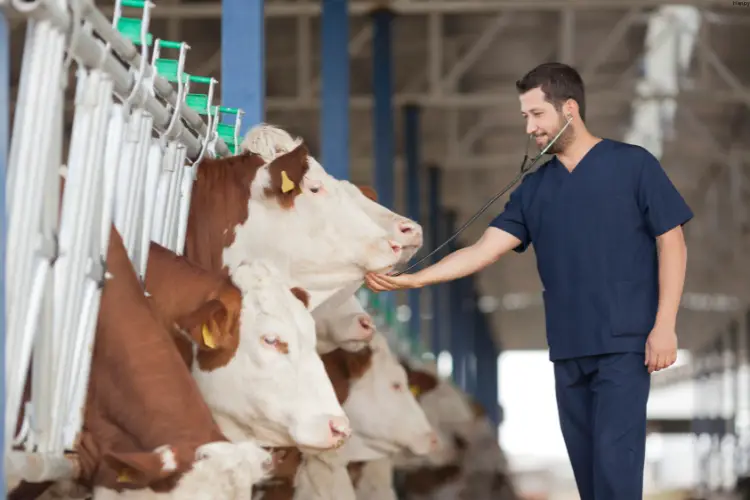
Preventive Care: Vaccination and Health Management Strategies
Maintaining the health and well-being of cattle is a crucial aspect of successful cattle farming.
Implementing effective preventive care measures, such as vaccination programs and comprehensive health management strategies, can significantly reduce the incidence of diseases and improve the overall productivity and profitability of the herd.
Vaccination Programs:
a. Importance of Vaccination: Vaccination is a crucial tool in the prevention and control of infectious diseases in cattle. By stimulating the animal’s immune system, vaccines help protect against the development and spread of various pathogens.
b. Recommended Vaccines: The specific vaccine program for a cattle herd will depend on the region, the prevalent diseases, and the production goals of the farm. Some commonly recommended vaccines include those for diseases such as BRD, BVD, leptospirosis, and clostridial diseases.
c. Vaccination Schedules: Establishing a well-planned vaccination schedule is essential to ensure the animals receive the necessary protection at the appropriate life stages and production phases. This may involve pre-breeding, pre-calving, and weaning vaccinations, among others.
d. Vaccine Administration: Proper vaccine handling, storage, and administration techniques are crucial to ensure the efficacy of the vaccines and to minimize the risk of adverse reactions.Herd Health Monitoring:
a. Regular Veterinary Checkups: Routine veterinary check-ups and herd health assessments can help identify potential health issues early, allowing for timely intervention and prevention.
b. Disease Surveillance: Implementing a system to monitor and track the incidence of diseases within the herd can provide valuable information for informed decision-making and the development of targeted disease management strategies.
c. Biosecurity Measures: Implementing robust biosecurity protocols, such as quarantine procedures for new arrivals, disinfection of equipment, and limiting visitor access, can help prevent the introduction and spread of infectious diseases within the herd.
d. Record-Keeping: Maintaining detailed records on the herd’s health, treatment history, and performance can assist in identifying trends, evaluating the effectiveness of preventive measures, and making informed decisions about herd management.Nutritional Management:
a. Balanced Rations: Providing a well-balanced and nutritious diet tailored to the specific requirements of the cattle’s age, production stage, and health status can help support their immune function and overall well-being.
b. Mineral and Vitamin Supplementation: Ensuring adequate supplementation of essential minerals and vitamins can help prevent deficiencies and associated health issues.
c. Feed Quality and Safety: Monitoring the quality and safety of feed and forage, and implementing proper storage and handling practices, can help mitigate the risk of contamination and the introduction of toxins.Environmental Management:
a. Optimal Housing and Facilities: Providing cattle with clean, well-ventilated housing, adequate space, and access to clean water can contribute to their overall health and comfort.
b. Parasite Control: Implementing effective parasite control measures, such as rotational grazing, pasture management, and the strategic use of dewormers, can help reduce the burden of internal and external parasites.
c. Fly and Insect Management: Employing strategies to minimize fly and insect populations, such as the use of fly traps, insecticides, and fly-proof housing, can help prevent the transmission of diseases and reduce stress on the animals.
By implementing a comprehensive preventive care program that includes vaccination, herd health monitoring, nutritional management, and environmental management, cattle farmers can significantly improve the health, productivity, and overall well-being of their herd, ultimately enhancing the sustainability and profitability of their cattle operation.
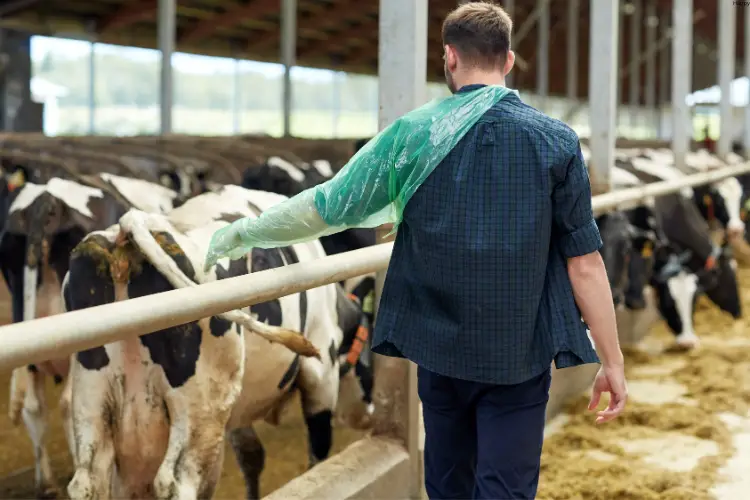
Behavior and Welfare: Understanding Cattle Behavior and Welfare Needs
Cattle are sentient beings with complex social and behavioral patterns. Understanding their natural behaviors and addressing their welfare needs is crucial for ensuring their overall well-being and productivity in a cattle farming operation.
1. Cattle Behavior:
a. Social Hierarchy: Cattle are herd animals and establish a social hierarchy within the group. They use various behaviors, such as vocalizations, body language, and physical interactions, to communicate and maintain their position within the hierarchy.
b. Foraging and Grazing Behavior: Cattle are ruminants and spend a significant portion of their time grazing and ruminating. They have a natural preference for diverse, high-quality forage and exhibit specific grazing patterns and behaviors.
c. Reproductive Behavior: Cattle have distinct mating and reproductive behaviors, such as heat detection, courtship, and parturition, which can provide valuable insights for effective breeding and calving management.
d. Behavioral Responses to Stress: Cattle can exhibit various behavioral changes, such as increased restlessness, aggression, or withdrawal, in response to stressors like handling, transportation, or changes in their environment.
2. Cattle Welfare:
a. The Five Freedoms: The Five Freedoms, a widely recognized framework for animal welfare, outlines the fundamental needs of cattle, including freedom from hunger and thirst, freedom from discomfort, freedom from pain, injury, or disease, freedom to express normal behavior, and freedom from fear and distress.
b. Housing and Facilities: Providing cattle with appropriate housing, including adequate space, shelter, bedding, and access to clean water, can significantly contribute to their overall comfort and well-being.
c. Handling and Restraint: Implementing low-stress handling techniques, such as using quiet movements, gentle prodding, and well-designed handling facilities, can reduce the animals’ fear and stress levels during routine management practices.
d. Pain Management: Addressing and managing sources of pain, such as injuries, illness, or painful procedures (e.g., dehorning, castration), through the use of pain-relief medications or alternative strategies, can improve the cattle’s welfare and reduce suffering.
3. Welfare Assessments and Monitoring:
a. Welfare Indicators: Monitoring a range of welfare indicators, such as body condition, lameness, injuries, and behavioral changes, can provide valuable insights into the cattle’s overall well-being and help identify areas for improvement.
b. Welfare Audits and Certifications: Participating in voluntary welfare audits or certification programs can help farmers demonstrate their commitment to animal welfare and align their practices with industry-recognized standards.
c. Continuous Improvement: Regularly reviewing and updating welfare practices, incorporating feedback from veterinarians and animal behavior experts, and implementing continuous improvement strategies can help ensure the ongoing enhancement of cattle welfare within the farming operation.
By understanding and addressing the behavioral needs and welfare requirements of cattle, farmers can create an environment that supports the animals’ natural behaviors, reduces stress and discomfort, and promotes their overall health and productivity.
This approach not only benefits the cattle but can also contribute to the long-term sustainability and profitability of the cattle farming operation.

Cattle Nutrition
Nutritional Requirements: Overview of Essential Nutrients for Cattle
Proper nutrition is a critical component of successful cattle farming, as it directly impacts the health, growth, and productivity of the herd.
Understanding the essential nutrients required by cattle and how to meet their nutritional needs is crucial for maintaining a thriving and efficient cattle operation.
1. Energy:
a. Carbohydrates: Carbohydrates, including starches and fibers, are the primary source of energy for cattle. They are essential for maintaining body condition, supporting milk production, and fueling growth and other physiological processes.
b. Fats: Fats, or lipids, provide a concentrated source of energy and are particularly important during high-energy demands, such as lactation or finishing.
2. Protein:
a. Amino Acids: Cattle require a balanced supply of essential amino acids to support the growth and maintenance of muscle, organ, and other body tissues.
b. Rumen-Degradable and Rumen-Undegradable Protein: Cattle have a unique digestive system that requires a combination of rumen-degradable and rumen-undegradable protein to optimize nutrient utilization.
3. Vitamins:
a. Fat-Soluble Vitamins: Vitamins A, D, E, and K are essential for various physiological functions, including vision, bone development, and immune system support.
b. Water-Soluble Vitamins: Vitamins of the B-complex and vitamin C play crucial roles in metabolism, nervous system function, and overall health.
4. Minerals:
a. Macrominerals: Cattle require adequate amounts of macrominerals, such as calcium, phosphorus, magnesium, and sodium, for skeletal development, muscle function, and other physiological processes.
b. Trace Minerals: Trace minerals, including copper, zinc, iron, and selenium, are needed in smaller quantities but are equally important for immune function, reproduction, and various enzymatic reactions.
5. Water:
a. Importance of Water: Water is an essential nutrient for cattle, as it is crucial for maintaining hydration, regulating body temperature, and supporting various physiological functions.
b. Water Requirements: The water requirements of cattle can vary depending on factors such as age, production stage, environmental conditions, and feed intake.
6. Forage and Roughage:
a. Importance of Forage: High-quality forage, such as pasture, hay, or silage, provides the bulk of the cattle’s diet and is essential for maintaining a healthy rumen and supporting overall digestive function.
b. Fiber and Rumination: The fiber content of forage is crucial for stimulating rumination and maintaining a stable rumen environment.
Balancing these essential nutrients in the cattle’s diet, considering factors like age, production stage, and environmental conditions, is crucial for ensuring optimal health, growth, and productivity.
Consulting with animal nutritionists, veterinarians, and experienced farmers can help develop customized feeding programs that meet the specific nutritional requirements of the cattle herd.
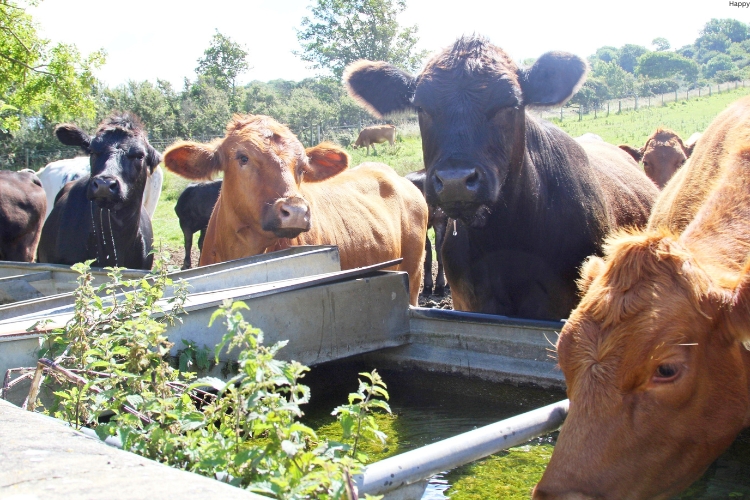
Feeding Strategies: Best Practices for Feeding Cattle
Proper feeding strategies are a critical component of successful cattle farming.
By implementing best practices in cattle feeding, farmers can ensure that their herd receives the necessary nutrients to maintain good health, achieve optimal growth and performance, and ultimately, contribute to the profitability of the operation.
1. Balanced Rations:
a. Nutrient Balancing: Developing a well-balanced diet that meets the specific nutritional requirements of the cattle, based on their age, production stage, and performance goals, is essential for supporting their overall health and productivity.
b. Forage-to-Concentrate Ratio: Maintaining an appropriate balance between forage (e.g., hay, pasture, silage) and concentrates (e.g., grains, protein supplements) in the cattle’s diet helps promote a healthy rumen environment and efficient nutrient utilization.
c. Supplementation: Strategically supplementing the cattle’s diet with essential vitamins, minerals, and other targeted nutrients can help address any deficiencies or imbalances and support specific production goals.
2. Feed Quality and Safety:
a. Forage Management: Ensuring the production and storage of high-quality forage, free from contaminants and with optimal nutrient content, is crucial for maintaining the health and performance of the cattle.
b. Feed Handling and Storage: Proper handling, storage, and rotation of feed and forage can help prevent spoilage, reduce the risk of mycotoxin contamination, and ensure the consistent delivery of nutrients to the cattle.
c. Water Quality: Providing clean, fresh water in sufficient quantities is essential for maintaining the cattle’s hydration and supporting various physiological functions.
3. Feeding Management:
a. Feeding Frequency and Distribution: Implementing a consistent feeding schedule and distributing the feed evenly throughout the day can help minimize feed waste and promote efficient nutrient intake.
b. Feeding Facilities: Designing and maintaining appropriate feeding infrastructure, such as feed bunks, troughs, and feeding alleys, can facilitate efficient feed delivery and reduce competition among the cattle.
c. Monitoring and Adjustments: Regularly monitoring the cattle’s body condition, feed intake, and performance, and making timely adjustments to the feeding program, can help optimize nutrient delivery and address any emerging issues.
4. Grazing and Pasture Management:
a. Rotational Grazing: Utilizing a rotational grazing system, where cattle are moved to different pastures or paddocks, can help maintain the quality and productivity of the grazing land, while also meeting the cattle’s foraging needs.
b. Pasture Improvement: Implementing pasture improvement techniques, such as soil testing, fertilization, and the introduction of diverse forage species, can enhance the nutritional value and sustainability of the grazing land.
c. Supplementation on Pasture: Strategically supplementing the cattle’s diet while on pasture can help address any nutritional deficiencies or imbalances and support their performance during specific production stages.
5. Transition Feeding:
a. Weaning: Carefully managing the weaning process, including the gradual transition from milk to solid feed, can help support the calf’s rumen development and minimize the risk of digestive upset.
b. Dry-off and Calving: Implementing appropriate feeding strategies during the dry period and the transition to calving can help prepare the cow for the physiological demands of lactation and reduce the risk of metabolic disorders.
By adopting these best practices in cattle feeding, farmers can ensure that their herd receives a balanced, high-quality diet that supports their overall health, growth, and productivity, ultimately contributing to the long-term success and sustainability of the cattle farming operation.

Cattle Reproduction
Reproductive Management: Overview of Reproductive Cycles and Management Strategies
Effective reproductive management is a critical aspect of successful cattle farming, as it directly impacts the herd’s productivity, profitability, and sustainability.
Understanding the reproductive cycles of cattle and implementing appropriate management strategies can help farmers maximize their breeding and calving outcomes.
1. Reproductive Cycles:
a. Estrous Cycle: Cattle have a regular estrous cycle, typically lasting 18-24 days, during which the female (cow or heifer) undergoes physiological and behavioral changes that prepare the animal for breeding and potential pregnancy.
b. Gestation Period: The gestation period in cattle is approximately 283 days, during which the developing fetus grows and matures within the uterus of the pregnant female.
c. Calving and Parturition: The process of calving, or parturition, is the final stage of the reproductive cycle, where the calf is delivered, and the cow transitions into the postpartum period.
2. Breeding and Breeding Management:
a. Breeding Soundness Evaluation: Regularly evaluating the breeding soundness of both males (bulls) and females (cows and heifers) helps ensure their reproductive fitness and fertility.
b. Breeding Season and Synchronization: Establishing an optimal breeding season and, if necessary, implementing estrous synchronization protocols can help improve breeding efficiency and achieve desired calving patterns.
c. Artificial Insemination (AI) and Natural Service: Cattle producers can choose between artificial insemination, which allows for the use of genetically superior sires, or natural service using breeding bulls, depending on their herd management and genetic improvement goals.
3. Calving and Calf Management:
a. Calving Assistance and Dystocia Management: Providing appropriate assistance and monitoring during the calving process, and addressing any cases of dystocia (difficult calving), can help improve calf survival and maternal health.
b. Colostrum Management: Ensuring that newborn calves receive adequate amounts of high-quality colostrum, which is rich in antibodies and essential nutrients, is crucial for their immune system development and early-life health.
c. Calf Weaning and Breeding Heifer Development: Implementing well-timed weaning practices and developing breeding heifers with appropriate growth and nutrition can set the stage for successful future breeding and calving.
4. Reproductive Performance Monitoring and Metrics:
a. Reproductive Efficiency Measures: Tracking key performance indicators, such as calving rate, calving interval, and services per conception, can help assess the overall reproductive efficiency of the herd and identify areas for improvement.
b. Reproductive Records and Data Management: Maintaining comprehensive records on breeding, calving, and reproductive events can provide valuable insights for decision-making and the development of targeted reproductive management strategies.
c. Veterinary Consultation and Reproductive Health Assessments: Collaborating with veterinarians to conduct regular herd reproductive health assessments and implement appropriate interventions can help optimize the herd’s reproductive performance.
By understanding the reproductive cycles of cattle and implementing comprehensive reproductive management strategies, cattle farmers can improve their herd’s breeding efficiency, calf crop, and overall productivity, ultimately enhancing the profitability and sustainability of their cattle farming operation.

Calving Practices: Best Practices for Calving and Newborn Care
Calving is a critical stage in the cattle production cycle, and ensuring the health and well-being of both the cow and the newborn calf is essential for the overall productivity and profitability of the herd.
By implementing best practices for calving and newborn calf care, cattle farmers can optimize calf survival, maternal health, and long-term herd performance.
1. Calving Facility Preparation:
a. Clean and Comfortable Environment: Providing a clean, well-bedded, and spacious calving area can help minimize the risk of infection and ensure the cow and calf’s comfort during the calving process.
b. Proper Lighting and Ventilation: Ensuring adequate lighting and proper ventilation in the calving area can facilitate monitoring and intervention during calving, as well as support the calf’s transition to the external environment.
c. Easy Access and Proper Restraint: Designing the calving facility with easy access for the farmer or veterinarian, and incorporating appropriate restraint systems, can enable safe and effective assistance during difficult calvings.
2. Calving Monitoring and Assistance:
a. Calving Stage Identification: Closely monitoring the cow’s behavior and physical changes can help the farmer recognize the different stages of calving and identify when intervention may be necessary.
b. Appropriate Intervention: Providing gentle, well-timed assistance during the calving process, such as helping to position the calf or addressing complications, can improve the chances of a successful delivery.
c. Dystocia Management: Recognizing and effectively managing cases of dystocia (difficult calving) through appropriate veterinary intervention, such as the use of calving aids or cesarean sections, can save the lives of the cow and calf.
3. Newborn Calf Care:
a. Ensuring Breathing and Circulation: Immediately clearing the calf’s airway and stimulating the calf to initiate breathing can be crucial for its survival and early-life development.
b. Colostrum Management: Ensuring the calf receives an adequate amount of high-quality colostrum, either from the dam or through supplementation, is essential for the development of the calf’s immune system.
c. Navel Disinfection: Properly disinfecting the calf’s navel can help prevent the introduction of pathogens and the development of navel infections.
d. Monitoring and Support: Closely monitoring the calf’s health, providing necessary support (e.g., warming, hydration), and addressing any issues in a timely manner can improve the calf’s chances of survival and thriving.
4. Cow-Calf Bonding and Maternal Care:
a. Facilitating Cow-Calf Bonding: Allowing the cow and calf to have uninterrupted time together after calving can help strengthen the maternal bond and encourage the calf’s natural nursing behavior.
b. Monitoring Maternal Behavior: Observing the cow’s maternal instincts and care for the calf can help identify any issues, such as rejection or neglect, that may require intervention.
c. Addressing Postpartum Health: Closely monitoring the cow’s postpartum health, including the involution of the uterus and the onset of estrus, can help ensure a smooth transition to the next breeding cycle.
By implementing these best practices for calving and newborn calf care, cattle farmers can optimize calf survival rates, improve maternal health, and lay a strong foundation for the long-term productivity and profitability of their herd.

Cattle Behavior
Understanding Cattle Behavior: Overview of Common Behaviors and Social Structures
Cattle are complex and intelligent animals with intricate behavioral patterns and social dynamics. Understanding their common behaviors and social structures is crucial for effective cattle management, as it enables farmers to create an environment that supports the animals’ natural tendencies and promotes their overall well-being.
1. Behavioral Repertoire:
a. Grazing and Foraging Behavior: Cattle are ruminants and spend a significant portion of their time grazing on pasture or consuming forage. They exhibit specific foraging patterns, such as selective grazing and rumination.
b. Resting and Lying Behavior: Cattle require adequate rest and lying time, which is essential for their physical and mental well-being. They often prefer to lie down in clean, comfortable areas.
c. Grooming and Self-Care: Cattle engage in self-grooming behaviors, such as licking and scratching, to maintain their coat condition and skin health.
d. Agonistic Behavior: Cattle can display agonistic behaviors, such as head-butting or pushing, as part of their social interactions and the establishment of dominance hierarchies.
e. Maternal Behavior: Cows exhibit strong maternal instincts, including protecting and nursing their calves, as well as behaviors associated with calving, such as nest-building.
2. Social Structures and Hierarchy:
a. Herd Dynamics: Cattle are herd animals and form complex social structures within their groups. They establish and maintain dominance hierarchies, which can influence access to resources and overall group dynamics.
b. Dominance Rank and Aggression: Dominant cattle, often older and larger individuals, use various behaviors, such as head-butting and displacement, to assert their status and maintain their position within the herd hierarchy.
c. Cow-Calf Relationships: The bond between a cow and her calf is particularly strong, with the calf relying on the mother’s care and protection during the early stages of life.
d. Group Cohesion and Synchronization: Cattle often exhibit synchronized behaviors, such as resting, grazing, and moving, as a result of their strong social bonds and the influence of dominant individuals within the herd.
3. Environmental Factors and Behavioral Responses:
a. Habitat and Spatial Requirements: Cattle have specific spatial and habitat requirements, such as access to shade, water, and diverse forage, which can influence their overall comfort and well-being.
b. Handling and Human Interaction: Cattle can be sensitive to human presence and handling, and they may exhibit behavioral changes, such as increased vigilance or avoidance, in response to perceived threats or stressful situations.
c. Stress and Behavioral Indicators: Cattle can display various behavioral indicators, such as increased restlessness, aggression, or changes in feeding and rumination patterns, in response to stressful stimuli or situations.
By understanding the common behaviors and social structures of cattle, farmers can create an environment that supports the animals’ natural tendencies, reduces stress, and promotes their overall well-being.
This knowledge can also inform the design of handling facilities, management practices, and decision-making processes to optimize cattle productivity and welfare.

Training and Handling: Techniques for Effective Cattle Training
Effective cattle training and handling are essential for the well-being of both the animals and the people working with them.
By implementing appropriate training techniques and handling practices, cattle farmers can enhance the safety of their operations, improve the animals’ responsiveness, and promote the overall efficiency of their cattle management.
1. Low-Stress Handling Principles:
a. Calm and Quiet Approach: Maintaining a calm, quiet, and patient demeanor when interacting with cattle can help reduce their stress levels and promote positive associations with human presence.
b. Herd Instinct and Flight Zone: Understanding the cattle’s natural herd instincts and flight zone (the area around an animal where they feel comfortable) can help handlers position themselves and move the animals in a manner that minimizes stress and fear.
c. Balanced Use of Pressure and Release: Applying gentle pressure to guide the cattle’s movement and then releasing that pressure at the appropriate time can help the animals learn and respond effectively to handling cues.
2. Foundational Training Techniques:
a. Halter Training: Familiarizing young calves with the use of a halter can facilitate handling and lead them to become more responsive to human interactions.
b. Desensitization and Habituation: Exposing cattle to various stimuli, such as handling, equipment, or novel situations, in a controlled and gradual manner can help them become more comfortable and adaptable to different handling scenarios.
c. Reward-Based Training: Incorporating positive reinforcement, such as providing treats or other rewards, can help shape the cattle’s behaviors and increase their willingness to cooperate during handling and training sessions.
3. Facility Design and Infrastructure:
a. Handling Facilities: Well-designed handling facilities, including chutes, holding pens, and alleyways, can help minimize stress, improve animal flow, and enhance the safety of both the animals and the handlers.
b. Lighting and Noise Control: Managing the lighting and minimizing excessive noise in the handling areas can help reduce the cattle’s anxiety and create a calmer environment for effective training and handling.
c. Flooring and Traction: Providing adequate traction and non-slip surfaces in the handling facilities can help prevent injuries and maintain the cattle’s balance and confidence during movement.
4. Handling Procedures and Personnel Training:
a. Routine Handling Practices: Establishing consistent and predictable handling routines, such as regular health checks, vaccinations, or transportation, can help the cattle become more accustomed to these necessary management practices.
b. Personnel Training and Competency: Ensuring that all personnel involved in cattle handling are trained in low-stress techniques and have the necessary skills and experience can enhance the safety and effectiveness of the handling processes.
c. Continuous Improvement: Regularly reviewing and updating handling practices, incorporating feedback from the animals and the handling team, and addressing any emerging issues can help continuously improve the cattle training and handling program.
By implementing these effective cattle training and handling techniques, farmers can create a working environment that promotes the well-being of their herd, enhances the safety of their operations, and contributes to the overall efficiency and profitability of their cattle farming enterprise.

Environmental Impact of Cattle Farming
Environmental Impact of Cattle Farming: Overview and Sustainable Practices
Cattle farming, like any agricultural activity, has a significant impact on the environment. Understanding the environmental implications of cattle farming and adopting sustainable practices are crucial for ensuring the long-term viability and responsible stewardship of the industry.
1. Environmental Impact of Cattle Farming:
a. Greenhouse Gas Emissions: Cattle farming, particularly through enteric fermentation (the digestive process of ruminants) and manure management, is a contributor to greenhouse gas emissions, such as methane and nitrous oxide, which can contribute to climate change.
b. Land Use and Deforestation: Cattle farming often leads to the conversion of natural habitats, such as forests, into pastures and grazing lands, which can result in the loss of biodiversity and ecosystem services.
c. Water Usage and Pollution: Cattle farming can place significant demands on water resources, both for irrigation and drinking water, and can also contribute to water pollution through the runoff of manure, fertilizers, and other agricultural chemicals.
d. Soil Degradation: Overgrazing and intensive cattle farming practices can lead to soil compaction, erosion, and depletion of soil nutrients, compromising the long-term productivity and sustainability of the land.
2. Sustainable Practices in Cattle Farming:
a. Sustainable Grazing Management:
i. Rotational Grazing: Implementing rotational grazing systems, where cattle are moved between different pastures or paddocks, can help maintain the health and productivity of the grazing land, while also reducing the impact on any single area.
ii. Pasture Improvement: Investing in pasture improvement techniques, such as introducing diverse forage species, improving soil fertility, and implementing targeted fertilization, can enhance the nutritional value and resilience of the grazing land.
b. Manure Management and Nutrient Cycling:
i. Manure Storage and Treatment: Proper storage, treatment, and application of cattle manure can help minimize the risk of nutrient runoff and greenhouse gas emissions, while also providing a valuable source of organic fertilizer for crop production.
ii. Anaerobic Digestion: Utilizing anaerobic digestion technology to convert cattle manure into biogas and nutrient-rich digestate can help generate renewable energy and recycle valuable nutrients back into the farming system.
c. Feed and Nutrition Optimization:
i. Feed Efficiency: Implementing strategies to improve the feed efficiency of cattle, such as optimizing the feed ration and utilizing feed additives or supplements, can help reduce the environmental footprint associated with feed production and procurement.
ii. Forage-Based Diets: Promoting the use of high-quality forage, including pasture and hay, in the cattle’s diet can help minimize the reliance on energy-intensive concentrate feeds and support more sustainable livestock production.
d. Carbon Sequestration and Land Stewardship:
i. Agroforestry and Silvopasture: Integrating trees, shrubs, and other perennial vegetation into the cattle farming system can enhance carbon sequestration, improve soil health, and provide additional ecosystem services.
ii. Wetland and Riparian Area Protection: Preserving and restoring wetlands, riparian areas, and other natural habitats on the farm can help safeguard biodiversity, regulate water flows, and mitigate the environmental impacts of cattle farming.
By adopting sustainable practices in cattle farming, farmers can work towards reducing the environmental footprint of their operations, promoting the long-term viability of the industry, and contributing to the broader goals of environmental stewardship and climate change mitigation.
Conclusion
Summary of Key Points:
Nutritional Requirements:
- Cattle require a balance of essential nutrients, including energy, protein, vitamins, and minerals, to support their health, growth, and productivity.
- Implementing a well-balanced feeding program that considers the specific needs of the herd is crucial for optimal cattle performance.
Feeding Strategies:
- Best practices in cattle feeding include developing balanced rations, maintaining feed quality and safety, and employing effective feeding management techniques.
- Grazing and pasture management, as well as strategic supplementation, are integral components of a comprehensive feeding strategy.
Reproductive Management:
- Understanding the reproductive cycles of cattle and implementing appropriate breeding, calving, and calf management practices can improve the herd’s breeding efficiency and overall productivity.
- Closely monitoring reproductive performance and collaborating with veterinary professionals are key to optimizing the reproductive health of the herd.
Calving Practices:
- Proper preparation of the calving facility, close monitoring and timely assistance during the calving process, and effective newborn calf care can enhance calf survival and maternal health.
- Facilitating strong cow-calf bonding and addressing postpartum health are crucial for a smooth transition to the next breeding cycle.
Understanding Cattle Behavior:
- Recognizing the common behaviors and social structures of cattle can inform management decisions and create an environment that supports the animals’ well-being.
- Applying low-stress handling principles and implementing effective training techniques can improve the safety and efficiency of cattle management.
Environmental Impact and Sustainable Practices:
- Cattle farming can have significant environmental implications, including greenhouse gas emissions, land use changes, and resource depletion.
- Adopting sustainable practices, such as sustainable grazing management, manure management, feed optimization, and carbon sequestration, can help mitigate the environmental impact of cattle farming.
Conclusion:
Effective cattle farming requires a multifaceted approach that considers the animals’ nutritional needs, reproductive management, behavioral characteristics, and the environmental impact of the operation. By implementing best practices in each of these areas, cattle farmers can optimize the health, productivity, and sustainability of their herds.
Developing balanced feeding programs, employing sound reproductive management strategies, understanding cattle behavior, and adopting sustainable farming techniques are all essential components of successful and responsible cattle farming. Continuous learning, collaboration with industry experts, and a commitment to animal welfare and environmental stewardship are key to navigating the complexities of cattle production and ensuring the long-term viability of the industry.
As cattle farming continues to evolve, staying informed and embracing innovative solutions will be crucial for cattle farmers to meet the growing demand for their products while minimizing the environmental footprint and upholding the highest standards of animal care. By taking a comprehensive and forward-thinking approach, cattle farmers can contribute to the overall sustainability and prosperity of the livestock industry.
